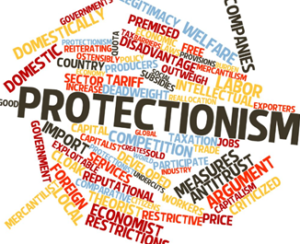Geopolitics should worry us more than protectionism.
The era of free trade seems to be over. How will the world economy fare under protectionism?”
Relevance
- GS Paper 2: Effect of policies and politics of developed and developing countries on India’s interests, Indian diaspora.
- GS Paper 3: Indian Economy and issues relating to planning, mobilization, of resources, growth, development, and employment.
- Inclusive growth and issues arising from it.
- Tags: # Protectionism #freetrade #uschina #currentaffairs #upsc.
Why in the News?
Dani Rodrik suggested The biggest risk is not this broader reorientation – which should be welcomed but its US-China rivalry that threatens to hurt everyone.
The Complex Landscape of International Trade
- The debate surrounding the shift from free trade to protectionism has become increasingly prominent. However, framing it solely as a dichotomy between these two concepts oversimplifies the dynamics of the global economy.
- In reality, the nuances lie in the intricacies of trade regulations, governance, and economic priorities.
Market Economy Requires Governance
- A market economy, by its nature, necessitates rules and regulations to ensure fair and efficient functioning.
- These rules are typically established and enforced by governments. When nations engage in international trade and finance, questions arise about whose rules should take precedence in a global marketplace.
Hyper-Globalization: Not True Free Trade
- The era of hyper-globalization, spanning from the early 1990s until the onset of the COVID-19 pandemic, did not represent traditional free trade.
- Trade agreements during this period focused less on removing cross-border barriers and more on intricate regulatory standards.
- These standards encompassed various domains, including health and safety regulations, investment, banking, intellectual property, and labor policies.
Prioritization of Big Businesses
- These regulations were far from neutral. They often favored politically connected large corporations.
- These businesses not only gained improved access to global markets but also benefited from international arbitration mechanisms that protected their profits from government regulations.
Impact on Intellectual Property and Labor
- Hyper-globalization also ushered in tighter intellectual property rules, granting pharmaceutical and tech giants significant power.
- Meanwhile, labor remained confined within national borders, and pressing issues like climate change and public health took a back seat due to business interests.
Backlash and Rebalancing
- In recent years, there has been a backlash against these policies, which some label as protectionism and mercantilism.
- However, this backlash represents a shift towards addressing critical national issues such as labor displacement, regional disparities, climate change, and public health.
- This reorientation aims to rectify the social and environmental damage caused by hyper-globalization and establish a more balanced form of globalization.
Examples of Reorientation
- US President Joe Biden’s policies, including industrial initiatives and green subsidies, exemplify this reorientation.
- While these policies may clash with established free trade norms, they provide models for those seeking alternatives to hyper-globalization.
Drawing Inspiration from Bretton Woods
- Examining the post-1945 Bretton Woods regime, which lasted until the early 1980s, offers valuable insights.
- During this period, governments retained significant autonomy over industrial and financial policies, with a focus on domestic economic well-being over global integration. Trade agreements were relatively weak, particularly for developing countries.
Bretton Woods Success Stories
- Despite its more closed global economy, the Bretton Woods era witnessed remarkable economic and social progress. Advanced economies experienced decades of rapid growth and reduced inequality.
- Low-income countries that pursued effective development strategies achieved significant growth despite facing higher trade barriers than today.
China’s Unique Path
- When China embraced the global economy after the 1980s, it did so on its terms, maintaining policies reminiscent of the Bretton Woods era, such as subsidies, state ownership, and capital controls.
Prioritizing Domestic Economic Health
- The legacy of the Bretton Woods regime underscores that allowing countries more flexibility to pursue their policies need not harm the global economy. Ensuring one’s domestic economic health can, in fact, benefit others.
Geopolitical Considerations
- However, today’s geopolitical landscape differs significantly from the Cold War era. China, a major global player, presents unique challenges in the context of international trade. Geopolitical competition between the US and China could have substantial economic repercussions.
US-China Dynamics and Their Global Impact
- If the global economy faces challenges, it will likely result from the mismanagement of geopolitical competition between the US and China, rather than any perceived abandonment of free trade principles.
- The intricacies of global economic dynamics require a more nuanced approach than a simple free trade vs. protectionism dichotomy.
- The shifting relationship between the United States and China holds significant implications for the world economy, raising concerns about potential repercussions stemming from geopolitical competition between these two major players.
What some decry as protectionism and mercantilism ruining the global economy is really a rebalancing towards addressing important national issues The biggest risk is not this broader reorientation but is US-China rivalry that threatens to hurt everyone
| Understanding the Bretton Woods System
The Bretton Woods System, established after World War II and spanning from 1945 to 1972, emerged from a gathering of representatives from 44 nations in New Hampshire in 1944. The primary objective was to create a new international monetary framework for the postwar era. Key Elements of the System – It advocated for a gold-and-foreign-currency-based exchange standard. – Each participating country fixed its currency’s value relative to the US dollar, which was pegged to gold at $35 per ounce. – The country holding the reserve currency, the US, aimed to maintain a balance of payments deficit to provide global reserves. Challenges and the Triffin Paradox – The system faced challenges when deficits became substantial, jeopardizing the stability of the reserve currency. – This dilemma, known as the Triffin paradox, highlighted the tension between a nation’s role as a global reserve currency holder and its domestic economic interests. Overall Objective – The primary goal of the Bretton Woods System was to facilitate postwar economic reconstruction and foster international economic cooperation following the devastation of World War II. The Collapse of the Bretton Woods System 1. US Gold Shortage Concerns: President Richard M. Nixon, alarmed by doubts about the United States’ ability to back its circulating dollars with gold due to a shortage, took action in 1971. 2. Dollar Devaluation: Nixon decided to devalue the US dollar concerning gold and temporarily suspended its convertibility into gold. This move was prompted by a rush on gold reserves. 3. Bretton Woods System’s End: By 1973, the Bretton Woods System had disintegrated. Nations were no longer obligated to fix their currency’s value based on the price of gold. 4. Exchange Rate Flexibility: Following the system’s collapse, countries gained the flexibility to adopt various exchange rate arrangements. They could peg their currency to another nation’s currency, a basket of currencies, or let it float freely, with its value determined by market forces relative to other currencies. |
Sources: LIvemint.
Mains Question
Analyze “The era of free trade seems to be over. How will the world economy fare under protectionism?” Discuss the nuanced shift from traditional free trade to hyper-globalization and its implications on global economic governance 250words.






